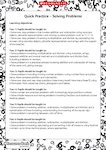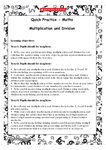Maths Ready-To-Progress Criteria – KS2
Add to My Folder
Find resources to use with the Department for Education’s new ‘ready-to-progress’ criteria for mathematics.
In July 2020 the government published new guidance for teaching mathematics at key stages 1 and 2 to help pupils progress through the National Curriculum. We have suggested a range of resources that can be used to help children to meet the objectives in the criteria. Below are the Key Stage 2 objectives and resources. Find the Key Stage 1 objectives and resources here.
Year 3
| Strand | Objective | Resource |
|---|---|---|
| Number and Place Value | Know that 10
tens are equivalent to 1
hundred, and that 100 is
10 times the size of 10;
apply this to identify and
work out how many 10s
there are in other three-digit
multiples of 10. Recognise the place value of each digit in three-digit numbers, and compose and decompose three-digit numbers using standard and non-standard partitioning. Reason about the location of any three-digit number in the linear number system, including identifying the previous and next multiple of 100 and 10. Divide 100 into 2, 4, 5 and 10 equal parts, and read scales/number lines marked in multiples of 100 with 2, 4, 5 and 10 equal parts. |
Quick Practice – Number and Place Value
Interactive Multiplication Square Quick Practice Maths – Number Sequences |
| Fractions | Interpret and write
proper fractions to
represent 1 or several
parts of a whole that is
divided into equal parts. Find unit fractions of quantities using known division facts (multiplication tables fluency). Reason about the location of any fraction within 1 in the linear number system Add and subtract fractions with the same denominator, within 1. |
Food divisions
Quick Practice – Fractions Quick Practice – Fractions Quick Practice – fractions, decimals, percentages Cake fractions Interactive: Pizzas ‘n’ Pies Fraction search game |
| Geometry | Recognise right
angles as a property of
shape or a description of
a turn, and identify right
angles in 2D shapes
presented in different
orientations. Draw polygons by joining marked points, and identify parallel and perpendicular sides. |
Quick Practice – Geometry |
| Number Formation | Secure fluency in
addition and subtraction
facts that bridge 10,
through continued
practice. Recall multiplication facts, and corresponding division facts, in the 10, 5, 2, 4 and 8 multiplication tables, and recognise products in these multiplication tables as multiples of the corresponding number. Apply place-value knowledge to known additive and multiplicative number facts (scaling facts by 10). |
Interactive Multiplication Square
Interactive Number Square |
| Addition and Subtraction | Calculate
complements to 100. Add and subtract up to three-digit numbers using columnar methods. Manipulate the additive relationship: Understand the inverse relationship between addition and subtraction, and how both relate to the part–part–whole structure. Understand and use the commutative property of addition, and understand the related property for subtraction. |
Adding in columns worksheet
Quick Practice – Solving Problems |
| Multiplication and Division | Apply known multiplication and division facts to solve contextual problems with different structures, including quotitive and partitive division. |
Quick Practice Maths – Multiplication and Division
|
Log in to your account to read
Published 2 October 2020
Reviews
You need to be signed in to place a review.



